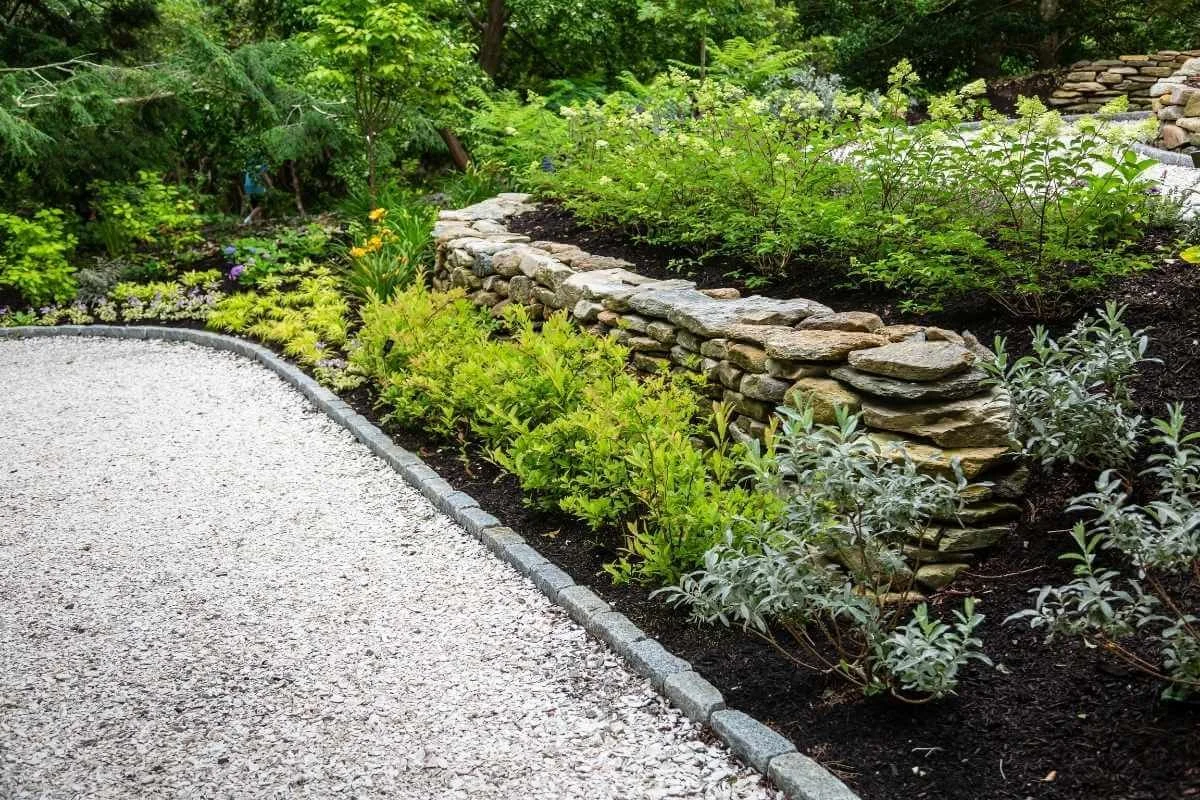The Compact and Versatile Love Child® Sweetspire Shrub
This native cultivar has it all! Pretty white flowers, fragrance, and brilliant red fall color.
Love Child® sweetspire (Itea virginica ‘Bailteaone’) is a cultivated variety of Virginia sweetspire, a deciduous shrub native to the mid-Atlantic and Southeastern United States.
This petite powerhouse was selected for its compact size and naturally rounded shape - much neater and more refined than the wild type - making it a smart pick for small gardens, tight foundation beds, or anywhere space is at a premium.
In late spring and early summer, Love Child® puts on a spectacular show with cascades of fragrant white flowers that dangle from arching branches like tiny fireworks. These blooms blanket the shrub in May and June, drawing in pollinators like bees and butterflies by the dozen.
Love Child® Virginia Sweetspire has a compact, naturally rounded shape. Image courtesy of Bailey Nurseries.
After the flower show ends, dry seed capsules form and remain on the plant through winter, offering both texture and bird food. Come fall, the foliage shifts to a rich burgundy, adding bold color and drama to the autumn landscape.
This is a low-fuss shrub that asks for little in return. Love Child® thrives in zones 5 through 9, prefers consistently moist, fertile soil, and can handle full sun to part shade (3-6+ hours of sun a day).
It's also happy in wet soils and can tolerate the occasional short-term standing water - great for those tricky spots in the yard. Not sure of your gardening zone? You can find it on the USDA’s Plant Hardiness Zone map.
Worried about deer? According to Rutgers University’s list of Landscape Plants Rated by Deer Resistance, deer “seldom severely damage” Virginia sweetspire and it is considered to be a deer resistant shrub. However, keep in mind that deer will browse almost any plant when nothing else is available…sigh 😔.
Fragrant white flowers cover Love Child® sweetspire from late spring to early summer. Image courtesy of Bailey Nurseries.
Tips for Growing Love Child® Sweetspire
Location: Love Child® sweetspire thrives in partial to full sun - 3 to 6+ hours of direct sunlight each day - and loves consistently moist, rich, well-drained soil. Avoid planting it in hot, dry spots or heavy clay, where it tends to struggle. If that’s your situation, the panicle hydrangea might be a better match.
Planting: Plant Love Child® sweetspire in spring or fall to give it a strong start before the extremes of summer or winter hit. Space shrubs 18-24 inches apart (center to center) so air can circulate freely. After planting, give it a nice, deep drink to help settle the roots.
Watering: Keep newly planted sweetspire well-watered while it establishes. Love Child® sweetspire appreciates steady moisture and won’t tolerate drought until it’s had 2-3 years to settle in. (Not sure how much is enough? See our “How to Water Your Plants” guide.)
Mulching: A cozy blanket of mulch helps retain soil moisture and keep weeds at bay. Just don’t let the mulch touch the base of the shrub - give it some breathing room! Read the University of New Hampshire Extension’s fact sheet on garden mulches to learn more.
Fertilizing: In early spring, treat the soil around your sweetspire to a balanced, slow-release fertilizer. Prefer a natural route? Compost, leaf mold, or a product like Leafgro will nourish the soil and improve structure over time.
Pruning: Love Child® sweetspire is naturally tidy and low-maintenance, so pruning isn’t usually needed. Just remove any dead or damaged branches as needed. If you do want to shape it, prune right after flowering to avoid trimming off next year’s blooms. Older, woody plants can be rejuvenated with a hard prune down to about 12 inches.
Pests & Diseases: Sweetspire is refreshingly trouble-free! While occasional leaf spot might show up, it’s rarely a serious issue.
Love Child® sweetspire turns red in fall. Image courtesy of Bailey Nurseries.
Landscaping Ideas for Love Child® Sweetspire
Japanese barberry replacement: Love Child® sweetspire is a great alternative to the invasive Japanese Barberry (Berberis thunbergii).
Foundation planting: The low, rounded shape of Love Child® sweetspire makes it the perfect choice for foundation plantings.
Water’s edge: Plant Love Child® sweetspire alongside a stream, creek, or pond, where its graceful arching flowers mimic the movement and flow of water.
Small gardens: Love Child® is the perfect choice for small gardens and yards. It will maintain its compact rounded shape and does not grow more than 4 feet tall and wide.
Wet areas: Virginia sweetspire loves well-draining, moist soil and thrives in damp, low areas. It can tolerate brief periods of standing water, making it appropriate to use in rain gardens and bioswales.
Border planting: Love Child® sweetspire can fill in the middle spaces of the garden border, in between low-growing perennials and taller shrubs or small trees.
Woodland garden: Naturalize Love Child® sweetspire in an open woodland garden, where it thrives in moist, rich soil and partial shade.
Butterfly or pollinator garden: Bees, butterflies and other pollinators flock to the flowers of Virginia sweetspire. It is also a caterpillar host plant, providing crucial real estate where butterflies can lay their eggs.
Edging: Soften the hard edges of patios, walkways, sidewalks and retaining walls with a row of Love Child® sweetspire shrubs.
Mass planting: Plant a mass group of Love Child® sweetspire shrubs alongside a fence, in a garden bed, or to stabilize a wet slope.
Fire pit landscaping: Plant a row of Love Child® sweetspire around the fire pit, where you can appreciate the deep burgundy fall color during autumn gatherings around the fire.
A row of Love Child® sweetspire softens the hard edges of a rock wall and creates visual interest. Image courtesy of Bailey Nurseries.
Great Planting Companions for Love Child® Sweetspire:
Winterberry Holly (Ilex verticillata): A classic native pairing! Winterberry’s red berries and Love Child® sweetspire’s fragrant blooms both offer food for birds and pollinators. Just remember to plant both a male and female holly for berries.
Mountain Hydrangea (Hydrangea serrata): Both mountain hydrangeas and sweetspire thrive in rich, moist soil and dappled shade - perfect for woodland edges or shady garden beds.
Oakleaf Hydrangea (Hydrangea quercifolia): Team up these two fall-color superstars for a bold autumn display. The deep burgundy foliage and bold leaf shape of the oakleaf hydrangea is truly unforgettable.
Panicle Hydrangea (Hydrangea paniculata): Moisture-loving just like sweetspire, panicle hydrangeas make a great companion in brighter spots. Mass them together in the landscape for bold texture and blooms.
Ivory Halo® Dogwood (Cornus alba ‘Bailhalo’): The red stems and variegated foliage of this dogwood contrast beautifully with Love Child®’s rich green leaves and fall color.
Dwarf Fothergilla (Fothergilla gardenii): With fragrant spring flowers and fiery fall foliage, dwarf fothergilla is a stunning match for Love Child® sweetspire in a native or seasonal interest garden.
Summersweet (Clethra alnifolia): Shade-tolerant and summer-blooming, this native shrub brings sweet scent and bright yellow fall color - perfect for layering with sweetspire in shadier garden beds.
Brilliant red fall leaves of Love Child® sweetspire. Image courtesy of Bailey Nurseries.
Follow Plant and Bloom Design Studio on Pinterest for more garden ideas!
Common name: Love Child® Virginia sweetspire
Botanical/Latin name: Itea virginica ‘Bailteaone’
Zones: 5 - 9
Mature size: 3-4 feet high and wide
Spacing: 18-24 inches on center
Light requirements: Full sun to partial shade (3-6+ hours of direct sunlight daily)
Form: Small, rounded deciduous shrub
Growth rate: Medium (13-24 inches per year)
Flowering time: May-June
Flower color: White
Flower form: Terminal arching racemes
Foliage type: Alternate, simple green leaves
Fall color: Deep burgundy
Deer resistant: Yes
Wildlife value: Butterflies, bees, birds, and pollinating insects





